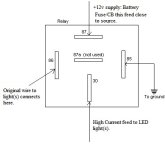Quick lesson on LEDs which will answer some of these wattage questions.

You can drive a LED off any voltage with a simple resistor. It will be on 100% of the time, and produce more heat.
But the most efficient way to do so is to pulse the LED, so it is only on part of the time - but still peaks at the same brightness. Above a certain hz this cannot be seen by the human eye. This allows the LED to make less heat, since it's only "on" part of the time. So, LEDs used in most applications (especially light bars/offroad lights/etc) use a LED driver to do this. They regulate to a specific "signal" (PWM) to the LED at a specific voltage themselves, so the input voltage may vary, but the output to the diodes will always be a constant voltage and current.
This is why there is a wider range of input voltages, why the output power/lumens/brightness stays the same no matter the input voltage, and the high-pitched "humming" you hear from some.
Take a 180W light. It's typically rated because it has 180 1W diodes, or 60 3W diodes, or whatever. You then have to consider the efficiency of the LED driver, which will means watts in != watts out. Then, also consider that the output could even be exactly 180W *peak*, but if it's only "on" 75% of the time, that's effectively 135W of constant current drawn.
Think about AC in your house - we call it 120v at the outlet, but it really goes between 0V and 170V! It averages out (RMS) to 120v.





